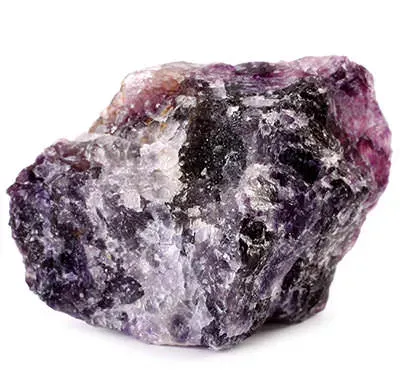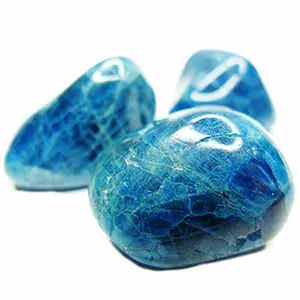 Apatite is a calcium phosphate, and a very rare variety of tourmaline, which was discovered in the 1990's. The name apatite comes from the word deceiver in Greek, because it is very easily mistaken for other stones, like tourmaline and
Apatite is a calcium phosphate, and a very rare variety of tourmaline, which was discovered in the 1990's. The name apatite comes from the word deceiver in Greek, because it is very easily mistaken for other stones, like tourmaline and ![]() beryl. With a hardness on the Moh's scale of only 5, it is rarely faceted as a gemstone, except for collectors. When cut correctly, stones are bright with strong colors. Apatite occurs in what has been described as neon colors, colors never seen before in jewelry. Because of these shockingly bright colors, the stone became popular overnight. Apatite can appear inconspicuous or display the most beautiful colors. It occurs in various shades of yellow, green, gray, blue, white, purple, pink, brown, red-brown, violet and colorless, as well as in cat's eye form. It has become popular because some of the striking blue and green colors resemble those of the highly prized Paraiba tourmaline. Yellow apatite is a more common color and costs a lot less than blue to green transparent varieties.
beryl. With a hardness on the Moh's scale of only 5, it is rarely faceted as a gemstone, except for collectors. When cut correctly, stones are bright with strong colors. Apatite occurs in what has been described as neon colors, colors never seen before in jewelry. Because of these shockingly bright colors, the stone became popular overnight. Apatite can appear inconspicuous or display the most beautiful colors. It occurs in various shades of yellow, green, gray, blue, white, purple, pink, brown, red-brown, violet and colorless, as well as in cat's eye form. It has become popular because some of the striking blue and green colors resemble those of the highly prized Paraiba tourmaline. Yellow apatite is a more common color and costs a lot less than blue to green transparent varieties.
 Apatite is opaque, though sometimes transparent. It is a glassy, hexagonal crystal that comes in various sizes and has a vitreous luster. It occurs as hexagonal prisms or tabular crystals and rates a 5 on the Moh's hardness scale. Because it is a very soft stone and doesn't wear well, it has not been used in jewelry until recently. However it has become very popular in the past few years because in its unusual green, blue and violet colors, it is very similar to the newcomer Paraiba tourmaline. Apatite is an abundant mineral found in many types of rock, but most gem quality material is associated with pegmatites. Blue apatite from Myanmar is strongly dichroic, showing colorless or blue when viewed from different directions. Fibrous blue apatite from Myanmar in Burma, and Sri Lanka may be cut en cabochon to show a cat's eye. Chatoyant stones are also found in Brazil, along with yellow, blue and green varieties.
Apatite is opaque, though sometimes transparent. It is a glassy, hexagonal crystal that comes in various sizes and has a vitreous luster. It occurs as hexagonal prisms or tabular crystals and rates a 5 on the Moh's hardness scale. Because it is a very soft stone and doesn't wear well, it has not been used in jewelry until recently. However it has become very popular in the past few years because in its unusual green, blue and violet colors, it is very similar to the newcomer Paraiba tourmaline. Apatite is an abundant mineral found in many types of rock, but most gem quality material is associated with pegmatites. Blue apatite from Myanmar is strongly dichroic, showing colorless or blue when viewed from different directions. Fibrous blue apatite from Myanmar in Burma, and Sri Lanka may be cut en cabochon to show a cat's eye. Chatoyant stones are also found in Brazil, along with yellow, blue and green varieties.
 Apatite is an abundant stone and is found in many other countries including the Kola Peninsula in Russia, and various locations in Canada, East Africa, Sweden, Spain and Mexico. A yellowish green variety of Apatite found in Spain is often called the asparagus stone because of its color. Apatite has been said to bring its wearer many beneficial qualities. It aids the immune system and cleanses the glandular, lymphatic and meridian systems. Psychologically, it detoxifies negative emotions relating to self-image. It helps the wearer to accept love, comfort, support, and self-love.
Apatite is an abundant stone and is found in many other countries including the Kola Peninsula in Russia, and various locations in Canada, East Africa, Sweden, Spain and Mexico. A yellowish green variety of Apatite found in Spain is often called the asparagus stone because of its color. Apatite has been said to bring its wearer many beneficial qualities. It aids the immune system and cleanses the glandular, lymphatic and meridian systems. Psychologically, it detoxifies negative emotions relating to self-image. It helps the wearer to accept love, comfort, support, and self-love.
 To ensure the best cleaning methods to protect your apatite, wash the stone with warm soapy water. Ultrasonic cleaning is definitely a risky process with this stone. In general, be sure to avoid exposure of the stone to acids, high heat and rough wear. Be careful with your stone, as it may lose or change color in heat. Exposure to a lot of light may fade some pink stones, although other colors are usually tolerant to it. Be extra careful to avoid any scratches or situations where the stone might risk being in risk with any kind of hard blows that might crack or chip it. It would be best to keep your apatite jewelry in a separate compartment of your jewelry case, and also wrap it with a soft cloth to avoid contact with anything that might scratch it. If you need to have the item repaired or remounted, make sure you advise your jeweler that the stone is fragile and requires specific handling and care.
To ensure the best cleaning methods to protect your apatite, wash the stone with warm soapy water. Ultrasonic cleaning is definitely a risky process with this stone. In general, be sure to avoid exposure of the stone to acids, high heat and rough wear. Be careful with your stone, as it may lose or change color in heat. Exposure to a lot of light may fade some pink stones, although other colors are usually tolerant to it. Be extra careful to avoid any scratches or situations where the stone might risk being in risk with any kind of hard blows that might crack or chip it. It would be best to keep your apatite jewelry in a separate compartment of your jewelry case, and also wrap it with a soft cloth to avoid contact with anything that might scratch it. If you need to have the item repaired or remounted, make sure you advise your jeweler that the stone is fragile and requires specific handling and care.